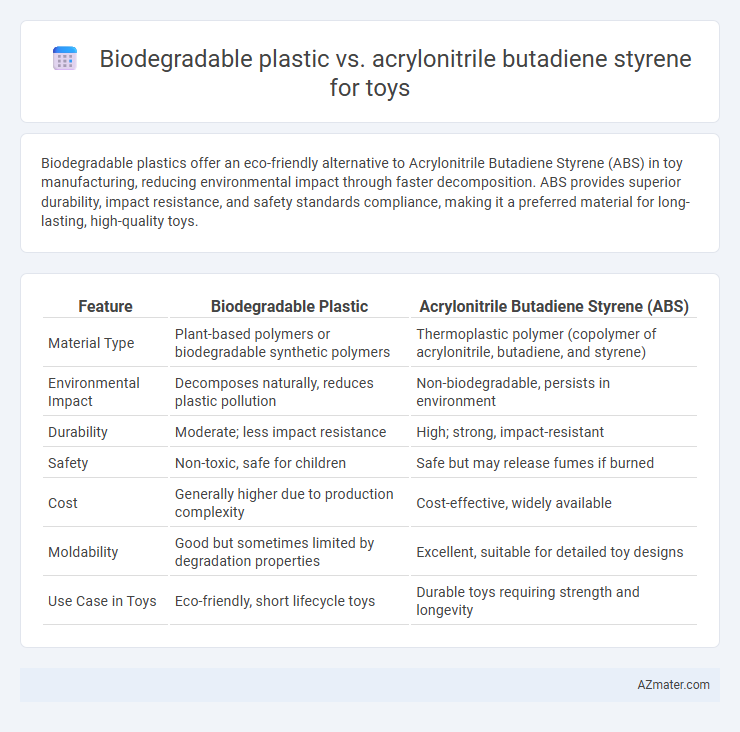Biodegradable plastics offer an eco-friendly alternative to Acrylonitrile Butadiene Styrene (ABS) in toy manufacturing, reducing environmental impact through faster decomposition. ABS provides superior durability, impact resistance, and safety standards compliance, making it a preferred material for long-lasting, high-quality toys.
Table of Comparison
| Feature | Biodegradable Plastic | Acrylonitrile Butadiene Styrene (ABS) |
|---|---|---|
| Material Type | Plant-based polymers or biodegradable synthetic polymers | Thermoplastic polymer (copolymer of acrylonitrile, butadiene, and styrene) |
| Environmental Impact | Decomposes naturally, reduces plastic pollution | Non-biodegradable, persists in environment |
| Durability | Moderate; less impact resistance | High; strong, impact-resistant |
| Safety | Non-toxic, safe for children | Safe but may release fumes if burned |
| Cost | Generally higher due to production complexity | Cost-effective, widely available |
| Moldability | Good but sometimes limited by degradation properties | Excellent, suitable for detailed toy designs |
| Use Case in Toys | Eco-friendly, short lifecycle toys | Durable toys requiring strength and longevity |
Introduction to Toy Material Choices
Biodegradable plastics and acrylonitrile butadiene styrene (ABS) represent two distinct categories of materials used in toy manufacturing, with biodegradable plastics offering environmentally friendly options due to their ability to break down naturally. ABS is favored for its high impact resistance, toughness, and ease of molding, making it ideal for durable and colorful toys. The choice between these materials depends on balancing environmental impact with mechanical performance and safety requirements in toy development.
What is Biodegradable Plastic?
Biodegradable plastic is a type of plastic designed to break down naturally through the action of microorganisms, reducing environmental pollution. This material is often made from renewable resources such as cornstarch or sugarcane, making it a sustainable alternative for toy manufacturing. In contrast, Acrylonitrile Butadiene Styrene (ABS) is a petroleum-based plastic known for its durability and strength but does not decompose easily, leading to long-term environmental concerns.
Understanding Acrylonitrile Butadiene Styrene (ABS)
Acrylonitrile Butadiene Styrene (ABS) is a durable thermoplastic polymer widely used in toy manufacturing due to its toughness, impact resistance, and ease of molding into complex shapes. Unlike biodegradable plastics, ABS offers superior strength and long-lasting performance, making it ideal for toys that require structural integrity and safety compliance. Its chemical composition, combining acrylonitrile, butadiene, and styrene, provides a balance of rigidity and resilience essential for high-quality, child-safe products.
Environmental Impact: Biodegradable Plastic vs ABS
Biodegradable plastics for toys significantly reduce environmental impact by breaking down naturally through microbial activity, minimizing long-term pollution and landfill accumulation. Acrylonitrile butadiene styrene (ABS), a petroleum-based polymer, poses environmental challenges due to its resistance to degradation and potential release of toxic substances during incineration. Choosing biodegradable plastics over ABS can lower carbon footprint and promote sustainable waste management in the toy industry.
Durability and Safety in Toys
Biodegradable plastics offer environmental benefits but generally lack the durability required for long-lasting toys, often degrading faster under stress and exposure. Acrylonitrile butadiene styrene (ABS) provides superior toughness, impact resistance, and stability, making it ideal for toys that endure rough play and frequent handling. ABS also maintains safety standards by being non-toxic and heat-resistant, reducing risks associated with breakage or chemical leaching in children's products.
Cost Comparison and Manufacturing Considerations
Biodegradable plastics typically incur higher raw material costs compared to Acrylonitrile Butadiene Styrene (ABS), but offer environmental benefits that can justify the premium in eco-conscious markets. ABS remains cost-effective due to established manufacturing processes, rapid cycle times, and excellent mechanical properties, making it the preferred choice for high-volume toy production. However, the shift towards sustainable manufacturing is driving investments to optimize biodegradable plastic processing, potentially reducing costs and improving scalability.
Regulatory Standards and Certifications
Biodegradable plastics used in toys must comply with international regulations such as ASTM D6400 and EN 13432, which certify their compostability and environmental safety. Acrylonitrile butadiene styrene (ABS) is subject to stringent safety standards like ASTM F963 and EN 71, ensuring non-toxicity, durability, and impact resistance for children's products. Both materials often require certifications from regulatory bodies such as the U.S. Consumer Product Safety Commission (CPSC) and the European Chemicals Agency (ECHA) to verify compliance with chemical content and safety performance.
Market Trends: Consumer Preferences in Toy Materials
The global toy market is increasingly shifting towards biodegradable plastic due to rising environmental awareness and demand for sustainable products among consumers, especially younger parents prioritizing eco-friendly options. Acrylonitrile butadiene styrene (ABS), known for its durability and impact resistance, remains popular but faces scrutiny regarding its non-biodegradable nature and environmental footprint. Market research indicates a growing preference for toys made from biodegradable polymers such as polylactic acid (PLA), driven by regulations and consumer demand for reducing plastic waste in children's products.
Case Studies: Biodegradable Plastic and ABS in Real Toys
Case studies comparing biodegradable plastic and acrylonitrile butadiene styrene (ABS) in toy manufacturing reveal distinct performance and environmental impacts. Biodegradable plastics, such as polylactic acid (PLA) and starch blends, demonstrate eco-friendly disposal and reduced carbon footprint but often fall short in durability and impact resistance compared to ABS, widely used for its strength and heat resistance in toy production. Real-world applications highlight biodegradable toys favored for sustainability in low-stress products, whereas ABS remains preferred for high-performance, long-lasting toys requiring rigorous safety standards.
Future Outlook: Sustainable Solutions for the Toy Industry
Biodegradable plastic offers a promising future for the toy industry by reducing environmental impact through materials like polylactic acid (PLA) and polyhydroxyalkanoates (PHA) that decompose naturally, contrasting with acrylonitrile butadiene styrene (ABS), a petroleum-based plastic known for durability but limited recyclability. Innovations in biodegradable polymers are enhancing mechanical properties to match ABS's strength, making them more viable for safe, eco-friendly toy production. Consumer demand for sustainable products and stricter environmental regulations are driving toy manufacturers to adopt biodegradable options, positioning these materials as key contributors to a greener industry.

Infographic: Biodegradable plastic vs Acrylonitrile butadiene styrene for Toy
 azmater.com
azmater.com